Roll the Dice and Move Forward
by Bob Brooke
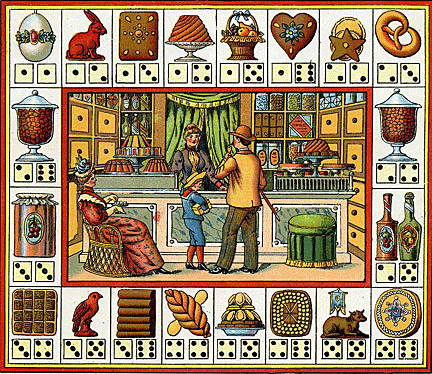 Lots
of people love to play board games. In fact, they were the primary
source of entertainment from the 1880s to the 1920s. Some families still
have a “family game night” where the entire family plays board games
instead of watching T.V. or talking or texting on their cell phones.
Collecting them is easy. However, to truly be a games collector, it’s
important to know more about their history in order to be on the lookout
for some unusual ones. Lots
of people love to play board games. In fact, they were the primary
source of entertainment from the 1880s to the 1920s. Some families still
have a “family game night” where the entire family plays board games
instead of watching T.V. or talking or texting on their cell phones.
Collecting them is easy. However, to truly be a games collector, it’s
important to know more about their history in order to be on the lookout
for some unusual ones.
Ranging from the games of the early I800s to the Baby Boomer games of
the 1960s, perhaps no field of antiques or collectibles so closely
documents the trends of popular culture and American history over the
last two centuries than board games. Each box is a small container of
our nation's history. giving subtle yet fascinating insights into the
American psyche over time.
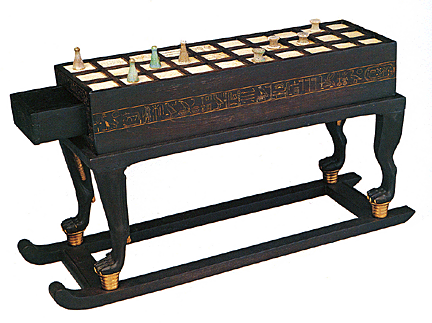 The
oldest board game is a game called “Senet.” Ancient Egyptians
played it during the Predynastic Period, dating it to around 3100 BCE.
The Romans played Ludus Latrunculorum, a two-player strategy board game
in which they called the board the “city” and the playing pieces “dogs.”
The pieces, each of one of two colors, enabled players to take a piece
belonging to their opponent by enclosing it with two of their own. The
oldest board game is a game called “Senet.” Ancient Egyptians
played it during the Predynastic Period, dating it to around 3100 BCE.
The Romans played Ludus Latrunculorum, a two-player strategy board game
in which they called the board the “city” and the playing pieces “dogs.”
The pieces, each of one of two colors, enabled players to take a piece
belonging to their opponent by enclosing it with two of their own.
Essentially, a board game is one played on a tabletop that involves
counters or pieces moved or placed on a pre-marked surface or "board",
according to a set of rules. While strategy plays a big part in some
games, many contain an element of chance. And some are purely chance,
requiring no skill.
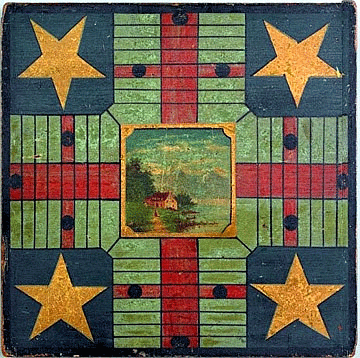 Games
usually have a goal that a player aims to achieve. Early board games
represented a battle between two armies, and most modern board games
still rely on defeating opponents in terms of counters, winning
position, or the accrual of points. Games
usually have a goal that a player aims to achieve. Early board games
represented a battle between two armies, and most modern board games
still rely on defeating opponents in terms of counters, winning
position, or the accrual of points.
There are many varieties of board games. Their representation of
real-life situations can range from having no inherent theme, like
checkers, to having a specific theme and narrative, like Clue. Rules can
range from the very simple, like Tic-tac-toe, to those describing a game
universe in great detail, like Dungeons & Dragons—although most of the
latter are role-playing games where the board, which serves to help
visualize the game scenario, is secondary to the game
In 17th and 18th century colonial America, the agrarian life of the
country left little time for game playing The Pilgrims and Puritans, who
preached that dice were the instruments of the Devil, didn’t help
matters with their negative views of game playing.
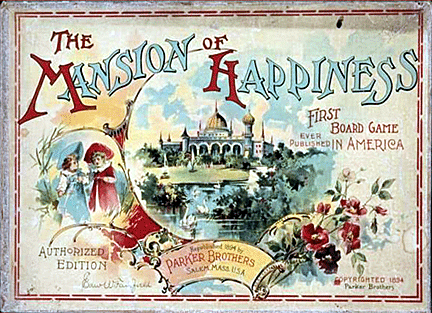 Christian
morality was the basis of the earliest board games published in the U.S.
The Mansion of Happiness from 1843, for example, sent players
along a path of virtues and vices that led to the Mansion of Happiness
or Heaven. The Game of Pope and Pagan, or The Siege of the Stronghold of
Satan by the Christian Army from 1844 pitted an image on its board of a
Hindu woman committing suttee against missionaries landing on a foreign
shore. The missionaries are cast in white as "the symbol of innocence,
temperance, and hope" while the pope and pagan are cast in black, the
color of "gloom of error, and grief at the daily loss of empire." Christian
morality was the basis of the earliest board games published in the U.S.
The Mansion of Happiness from 1843, for example, sent players
along a path of virtues and vices that led to the Mansion of Happiness
or Heaven. The Game of Pope and Pagan, or The Siege of the Stronghold of
Satan by the Christian Army from 1844 pitted an image on its board of a
Hindu woman committing suttee against missionaries landing on a foreign
shore. The missionaries are cast in white as "the symbol of innocence,
temperance, and hope" while the pope and pagan are cast in black, the
color of "gloom of error, and grief at the daily loss of empire."
Few early games were complex or innovative. Most relied on a player's
luck in spinning an arrow, tossing dice or hooking a game piece. And all
were based on Christian morality.
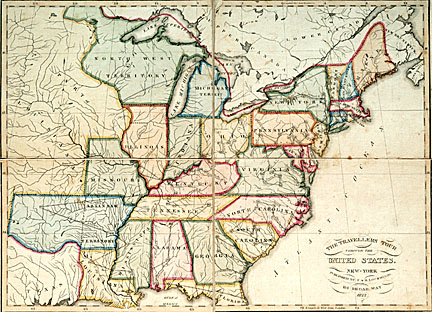 Traveler's
Tour Through the United States, published by New York City
bookseller F. & R. Lockwood in 1822, was the first board game published
in the United States. Traveler's
Tour Through the United States, published by New York City
bookseller F. & R. Lockwood in 1822, was the first board game published
in the United States.
Even though New York City was the center of the board games industry,
early board games reflected the nation’s values and aspirations.
As the U.S. shifted from agrarian to urban living in the 19th century,
the middle class had more income and more leisure time. The American
home became a place of entertainment, enlightenment, and education.
Mothers encouraged their children to play board games that developed
literacy skills and provided moral instruction.
Commercially produced board games in the mid-19th century featured
monochrome prints hand-colored by teams of low-paid young factory women.
The development of chromolithography, a technological achievement that
made bold, richly colored images available at affordable prices, enabled
commercial production of inexpensive board games.
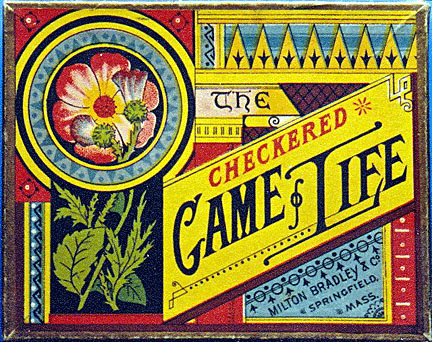 In
1860, The Checkered Game of Life rewarded players for mundane
activities such as attending college, marrying, and getting rich. Daily
life rather than eternal life became the focus of board games. The game
was the first to focus on secular virtues rather than religious ones and
sold 40,000 copies its first year. In
1860, The Checkered Game of Life rewarded players for mundane
activities such as attending college, marrying, and getting rich. Daily
life rather than eternal life became the focus of board games. The game
was the first to focus on secular virtues rather than religious ones and
sold 40,000 copies its first year.
During the Civil War, board games told about culture in the United
States. In the Mansion of Happiness from 1864, players won based on the
Puritan view that success is achieved through Christian deeds and
goodness. Players advance by landing on spaces denoting virtues like
piety and humility, and move backward when landing on spaces like
cruelty and ingratitude.
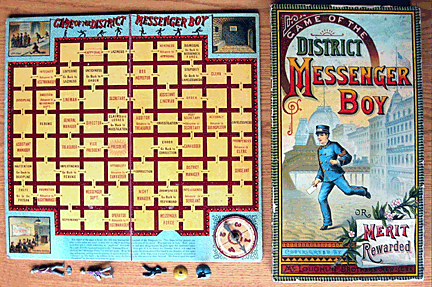 By
the 1880s, many games had a rags-to-riches theme. In Game of the
District Messenger Boy, published in 1886 by the New York City firm
of McLoughlin Brothers, players were rewarded for landing on spots with
attributes. It was one of the first board games based on materialism and
capitalism. The game is a typical roll-and-move track board game that
encouraged the idea that the lowliest messenger boy could ascend the
corporate ladder to its topmost rung. Such games insinuated that the
accumulation of wealth brought increased social status. Players move
their tokens along the track at the spin of the arrow toward the goal at
the track's end. Some spaces on the track advanced the player while
others sent him or her back. By
the 1880s, many games had a rags-to-riches theme. In Game of the
District Messenger Boy, published in 1886 by the New York City firm
of McLoughlin Brothers, players were rewarded for landing on spots with
attributes. It was one of the first board games based on materialism and
capitalism. The game is a typical roll-and-move track board game that
encouraged the idea that the lowliest messenger boy could ascend the
corporate ladder to its topmost rung. Such games insinuated that the
accumulation of wealth brought increased social status. Players move
their tokens along the track at the spin of the arrow toward the goal at
the track's end. Some spaces on the track advanced the player while
others sent him or her back.
In 1883, Bulls and Bears: The Great Wall St. Game promised it
would make players feel like "speculators, bankers and brokers" and
featured cartoons of railroad barons Jay Gould and William Henry
Vanderbilt.
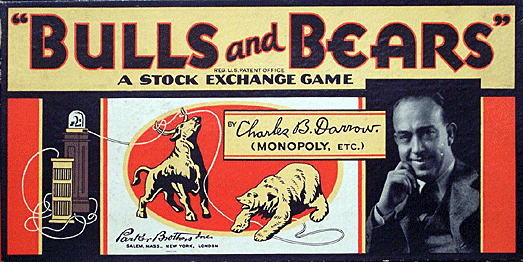
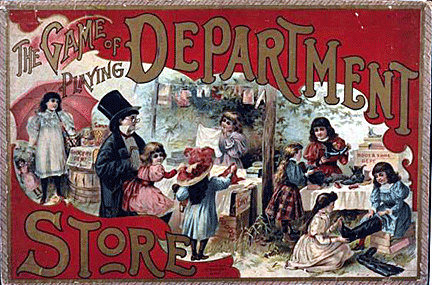 The
Game of Playing Department Store from 1898, showed what a novel
concept it was for Americans to do all their shopping under one roof.
Round the World With Nellie Bly from 1890, illustrated the Victorian
era's fascination with travel and exploration, while Rival Policeman
from 1896 uses as its base the real-life story of a time when New York
City had two competing police departments. The
Game of Playing Department Store from 1898, showed what a novel
concept it was for Americans to do all their shopping under one roof.
Round the World With Nellie Bly from 1890, illustrated the Victorian
era's fascination with travel and exploration, while Rival Policeman
from 1896 uses as its base the real-life story of a time when New York
City had two competing police departments.
Board Games in the 20th Century
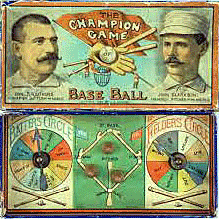 Much
of the American board game collecting market, however, focuses on the
20th century. Board games have become far more popular in the last
century and many more games have been produced. These games provide a
piecemeal history: of the current century, closely mirroring the history
and popular Culture of our times and the recent past. Much
of the American board game collecting market, however, focuses on the
20th century. Board games have become far more popular in the last
century and many more games have been produced. These games provide a
piecemeal history: of the current century, closely mirroring the history
and popular Culture of our times and the recent past.
Throughout the 1920s, the great aviation feat yet to be accomplished was
that of crossing the Atlantic Ocean. During this period a number of
games were created relating to the basic theme of crossing the Atlantic.
One of these games was Parker Brothers' Hop-Off, in which pieces were
moved across a map of the ocean. When Charles Lindbergh finally
succeeded in crossing the Atlantic in 1927, Parker Brothers came out
with an updated version of its game, calling it Lindy Hop-Off.
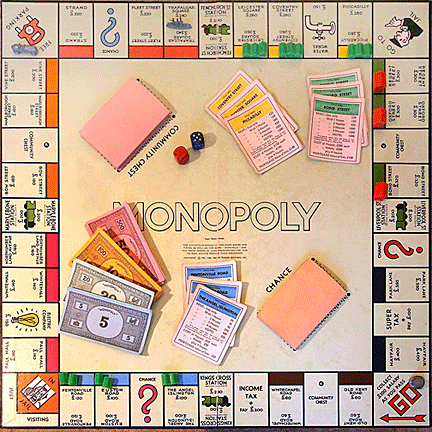 The
1930s saw the rise of a number of money related games, including
Monopoly. Also during that period, games based on the politics of
the time were created. A company named All Fair came out with a game
called WPA, named after the New Deal program of the same acronym. The
1930s saw the rise of a number of money related games, including
Monopoly. Also during that period, games based on the politics of
the time were created. A company named All Fair came out with a game
called WPA, named after the New Deal program of the same acronym.
During World War II there were again a number of military games and
games related to the war. A company named Waltham produced a game called
Dictator. In good condition, this game could sell for around
$250. Also during that period there was a game called Ration Board,
based on the wartime rationing that Americans were experiencing.
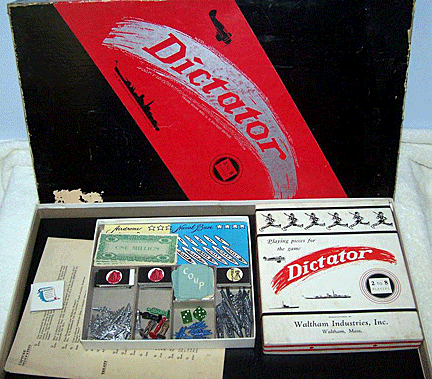 During
the 1950s and 1960s many Americans played board games based on T.V.shows
and musical groups There was a board game based on Groucho Marx's famous
quiz show "You Bet Your Life.” The Beatles, of course, had a board game,
as did the Monkees. During
the 1950s and 1960s many Americans played board games based on T.V.shows
and musical groups There was a board game based on Groucho Marx's famous
quiz show "You Bet Your Life.” The Beatles, of course, had a board game,
as did the Monkees.
Many board games require some level of skill and luck. Game makers
introduced luck into their games using a variety of methods. The most
common is the use of dice, which dates back to ancient Rome. A roll of
the dice can decide everything from how many steps a player moves their
token, as in Monopoly, to how their forces fare in battle, as in Risk,
or which resources a player gains as in The Settlers of Catan. Other
games employ spinning an arrow or hooking a game piece, as in chess, as
a way of introducing luck into the game.
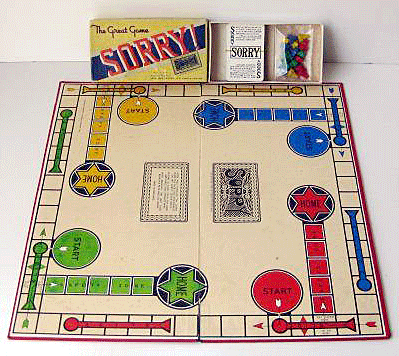 Randomness
is also an element that promotes luck in many board games. The Game
of Sorry! uses a deck of special cards that, when shuffled,
create randomness. Scrabble does something similar with randomly picked
letters. Other games use spinners, timers of random length, or other
sources of randomness. Randomness
is also an element that promotes luck in many board games. The Game
of Sorry! uses a deck of special cards that, when shuffled,
create randomness. Scrabble does something similar with randomly picked
letters. Other games use spinners, timers of random length, or other
sources of randomness.
But there’s also a cultural element to board games. The game of Monopoly
wasn’t the first to have a “greed is good” theme. In 1883, Bulls and
Bears: The Great Wall St. The The game promised it would make players
feel like "speculators, bankers and brokers" and featured cartoons of
railroad barons Jay Gould and William Henry Vanderbilt.
Many of the games are also beautiful works of art, with bold designs and
bright colors, featuring fanciful characters or outrageous cartoons,
often based on nursery rhymes, fairy tales or stories plucked from the
headlines.
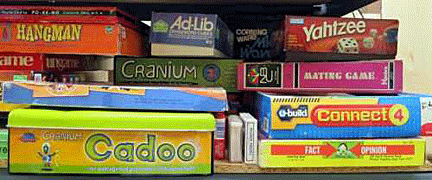 Old
and vintage board games are probably one of the most common items found
at garage and yard sales, church sales, and flea markets. As kids grow
up and leave the nest, parents either sell their games or give them
away. Old
and vintage board games are probably one of the most common items found
at garage and yard sales, church sales, and flea markets. As kids grow
up and leave the nest, parents either sell their games or give them
away.
Collectors often focus on the history of one game, such as Monopoly.
There have been so many versions of it produced over the years, that a
person could collect only that game and no other. Of course, collectors
also focus on role-playing games, buying and selling games, economic
stimulation games, educational games, and many other categories.
<
More Special Features
Next Article > |
